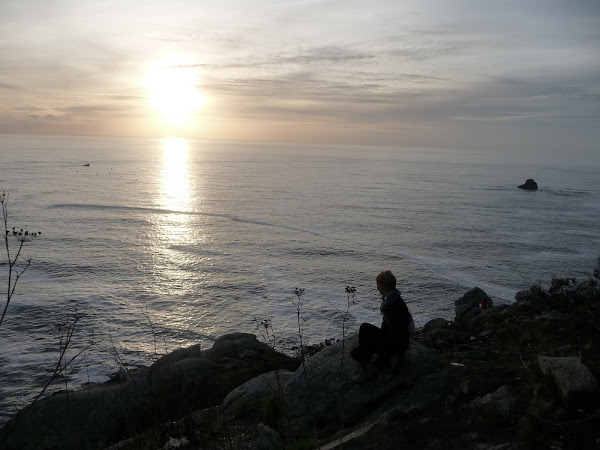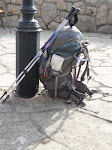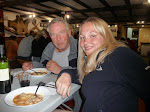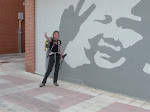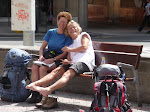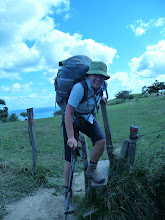Gosh what an adventure this was - planning my 2 outfit wardrobe. Having quite a substantial closet of clothing, the idea of narrowing my clothing to limited essentials was quite a challenge! = no kidding!! I had lots of advice though and experience from many camping and canoe trips and other adventures, so I knew my way around the outdoor stores. I also had a great amount of advice from my friend Anita who had done the Camino twice and provided me with not only a demonstration of her back pack and contents but also the detailed list of everything she recommended would be required.
I started shopping around for clothes about 6 months before I left, tried out fabrics for comfort, warmth/coolness and importantly I test washed things to see how fast they would dry from being hung overnight. One thing I learned quickly on the walk was that you needed to plan to stop early enough to wash clothes so that they could dry on the line before it got dark. Because I walked in warm and sunny weather for the most part, clothes were often dry within an hour or so. As well, many albergues had washing machines and clothes dryers which was great when I wanted to wash more than just what I was wearing. Sometimes I shared the machine with another pilgrim to make it more feasible - cost was minimal.
Not only did I test out the washability, but also just how much and what kind of laundry soap would work. After some trial and error, I chose to carry one bar of soap which I used for both shower and clothes and this worked well. I brought a bar of great smelling soap like Irish Spring as it was a wonderful and refreshing scent to shower with at the end of the day. Two things matter at the end of the day - one is the shower and the other is the snooze after everything is washed and hung!
I eventually ended up with more clothing than I needed and then had to determine what would go and what would be left behind. This is where the weight issue came into play. I chose fabrics that were especially light weight, looked for bottoms that had zip offs but could not find the fabric that would be light enough. I ended up taking one pair of capri pants and 2 pairs of shorts which worked fine, except that it was a bit awkward to change into shorts as the day warmed up around 10 am.
The goal in choosing clothing is related to the time of year for walking and I expected it to be fairly hot with some cool weather in the morning and late evenings. I was pretty much on target with this, but was able to buy a light weight fleece about half way along the walk due to cooler than normal temperatures in the early morning.
So here is what I packed and I give a lot of credit to Anita for starting this list.
REMEMBER - weight is everything!! so choose carefully!
Clothes - choose dark colors - no pastels as they just don't stay clean looking
2 pairs of bottoms - ideally pants that zip off into shorts
Anita actually bought two identical pairs of zip offs and then took only one bottom section and two shorts sections (to reduce weight)
2 short sleeve tops - light, breathable fabric
1 light weight long sleeve top
1 light weight zip up top
2 pairs of underwear (bra and pants) made of micro fibre and black so you can sleep in, use as a bathing suit and is less like underwear in co ed bathrooms and dorms
2 - 3 pairs of wool socks (smart wool)
1 pair of sandals - light weight!, comfortable and durable as you might end up wearing these during the day if your feet get sore. Don't bring crocs.
Flip flops for wearing in the shower stalls (prevents foot infections if you have open blisters)
Hiking Boots and orthotic inserts
Rain Gear - pants, jacket and cover for back pack. I got a thing called the packa which was a jacket with a large pocket at the back that went over my back pack (available at thepacka.com) It worked pretty well, but in a heavy down pour on a practice walk, I discovered that my back pack was damp so I used a cover for it under the packa. Ponchos were common, but awkward to get into and if it really rains hard you will need rain pants as the poncho will blow around. I also had everything in the back pack inside plastic bags. I would probably take a light weight regular rain jacket next time as it can be used in the early mornings against the cold wind.
Sun Hat with a good brim and air vents
Fleece hat and gloves or mitts as the mornings can be quite nippy
Bandana was handy to wear around my neck for hot and sweaty days and for warmth in the cool mornings
Back Pack - 30 litre size and fitted for your body size. Study the design and get a lesson in how to adjust and pack the thing at the store. Test it out with a hike, fully packed to make sure it is comfortable. You would not believe the troubles caused by back packs that did not fit, were not adjusted or packed very well. This will become your friend and really needs careful research and testing before departure. Do not load it heavier than 8 - 10 kgs, as you will only end up giving things away in the first 4 days of carrying it.
Toiletries
Soap (bar for shower and clothes washing) and shampoo in small container
(I tried for several weeks prior to departure testing out how much shampoo I really needed to wash my hair and how long the small container would therefore last)
Toothbrush and toothpaste (travel variety), floss
Comb/brush, razor?
Deodorant
Wax ear plugs - lots of snoring sometimes
Toilet paper - sometimes there is none
Sun block
Lotion - for your feet and dry skin
I would take a small vial of aroma therapy for my feet next time and some sheep skin to slip them into at night
Pharmaceuticals
ibuprofen, gravol, immodium, tylenol,
There are phamacias everywhere and they will be able to provide whatever you need.
First Aid - bandaids, antibiotic cream
Foot Care - white tape or duck tape, iodine, needle and white thread - lots of band aids (although you can also buy these everywhere
Emergency blanket - thin foil wrap in case of emergency (also water proof)
Any personal meds you need
Other Items
Very small camera with a case - one change of batteries - also sold everywhere. There are also places in the dorm to plug in chargers at night - you will need a plug for Europe and do something to remind yourself to pick up your charger in the morning - easy to forget things as you rush to get out on the trail each day.
Sun glasses
Wallet or money belt for valuables (I also brough along a very light weight cross shoulder bag that I used in the evening)
Travel towel - you don't need a very large one
Small cloth for wiping or drying hands during the day (could hang from the back pack)
8 - 10 clothes pins
8 - 10 safety pins to hang damp socks from your back pack
Small light weight rope in case you need to make you own clothes line (even around your bunk at night)
Light weight sleeping bag - you don't need a liner, but some people had them
Pillow case - standard size - to put over the pillows in the dormitories
Cell phone - I got this over the internet with info that came with the train tickets I had ordered on line. It was set up to use in Europe for a reasonable rate. Good to carry with me - comforting to know family could find me. Cell phone connections were fine all along the way. However, you can buy phone cards everywhere cheaply and use these as well in any pay phone. Although often there can be a line up for the phone and it is usually located in a noisy area or bar etc - so not much privacy if that matters to you.
Also:
Water bottle
Camel Pack for inside the back pack - I learned not to fill it completely (4lb) if there was water along the way. I also found this was a much more convenient way to manage hydration during the day - easy to sip on water more frequently as opposed to trying to get a water bottle out of a back pack pocket while you are walking. I think I drank more as a result, as others had to remind themselves to stop and drink. Hydration in warmer weather is very critical.
Cup, bowl and spork (combination fork and spoon), swiss army knife
Trecking poles that can collapse and you can pack inside the back pack for the flight
Head Lamp or flashlight - but head lamp preferred with adjustable focus and a very bright white light - try this out before you leave as it is very important
Whistle - for emergency and study the codes for what each whistle sound means
Watch with a light mechanism for night time
Dry Sac or Water proof bag - I took my valuables right into the shower with me sometimes to keep everything safe.
Then don't forget
Notebook and pen for your journal
Spanish phrase book (small one)
Passport
Pilgrim passport - you can get this anywhere you start
Confraternity guides - provides info on the alberques.
Other guides to provide info along the way (choose a very small and light book)
I noticed that people had either photo copied their books so they could discard pages along the way or unnecessary pages were cut out as we went along. The guide books were very helpful to plan what would be seen each day as we walked.We would study highlights of the walk for the following day each evening.this way we were able to understand and enjoy the environment with some knowledge.
Tickets
Travel insurance
Emergency contact info
Credit card
Bank card (4 digit password)
Packing Advice
Use lots of zip lock bags. I was able to find very large zip lock bags to line the inside of my back pack at Walmart. I was a bit manic about keeping things dry. Then I put almost everything into smaller versions of zip lock bags to keep them waterproof and just to organize things, for example - foot care in one bag to pull out with one effort.
Pack things you will need least in the bottom and heavier items in the middle.
And here is another tip - be very methodical with every thing. Pack your things in the same order so you know where to find them - store things that are valuable carefully and in the same place - have a routine each day with unpacking and then loading up again before you go to bed. have a mental checklist of those items that you do not want to lose track of ie camera, wallet, hiking poles etc and keep the same pattern day after day and you are less likely to forget or lose things as you go along. For example I always walked with my camera slung cross ways over my shoulder and became accustomed to feeling it there. At night I buried it deep in my back pack which I always hung over a corner of my bunk or I put it in the bottom of my sleeping bag at night. I did the same with my wallet - had a careful and consisten pattern of looking after it.
Good Luck
Maggee
Wednesday, January 7, 2009
Travel Planning
This was the most fun - planning an excursion which was largely mental work and searching the internet for alternate ways to get to the starting point that I had chosen at St Jean Pied de Port in the south of France. I discovered a lot of information on the internet under various locations regarding train travel in Europe and most inportantly how to connect between the airports and the train routes.
As it turned out, I chose the best way to get to the south of France by flying into Paris and then taking two trains to St Jean Pied de Port. What I learned is that while St Jean appears closer to Spain on the map, the connection by train is awkward because the rail lines are dissimilar and do not run in straight north south directions across the countries. More choice seems to be available to arrive in Paris then choose a short flight to a city in the south or just get to the train station in Paris and ride through the beautiful vistas of the south of France.
It was easy to find my way through the Charles de Gaule airport as there are information stations everywhere and people are most helpful even with a little bit of French. Finding the metro into Paris was easy, getting a ticket from the machine with my visa card done with a little assistance from someone standing nearby and then following the directions and the metro stops to get to the centre of the city was not a problem at all. The train station I needed was about 3 blocks from the metro station and this was negotiated quickly with help from people on the street.
What I did not do well was to leave myself enough time between flight arrival and train departure and so with less than 2 hours - I made my train connection with literally minutes to spare. The ticket I was able to get through the internet was first class (very cheap) and was a real treat for the 5 hours it took to get to Bayonne where I transfered to the smaller older train that took us through the mountains to St Jean.
The challenge is to plan your flight to arrive at a time when you can make train connections required to get to the final destination - a real stroke of luck I discovered with limited times in between transfers.
On the return journey, I had only booked my return flight from Paris and was not sure how I would get from there Santiago. The frustration during the early part of the walk was knowing that I had a deadline of getting to Paris within 35 days and it was not until I realized in about the second week that I would complete the walk in the time alloted that I was able to settle down and stop worrying about this. I also had a bit of a challenge trying to figure out how to book a flight during my walk between Santiago and Paris and ended up getting my daughter to do this for me from Canada. All worked out and it was very easy, although because I left it so late, probably more expensive to book this flight than it could have been if I had chosen this route much earlier. I had it in my mind that I might want to take a train all the way back to Paris, but the time did not allow me to do this.
I took on the travel arrangements as kind of an adventure in exploring options and learned a lot about travel in Europe along the way, more about the geography of France and certainly gained a lot of confidence in being able to sort out how to plan this trip from start to finish for myself.
There are a variety of ways to organize the travel plan and many destinations to head for from North America and from Eurpoe as a matter of fact, so in searching out what will work for you is filled with lots of options.
Maggee
As it turned out, I chose the best way to get to the south of France by flying into Paris and then taking two trains to St Jean Pied de Port. What I learned is that while St Jean appears closer to Spain on the map, the connection by train is awkward because the rail lines are dissimilar and do not run in straight north south directions across the countries. More choice seems to be available to arrive in Paris then choose a short flight to a city in the south or just get to the train station in Paris and ride through the beautiful vistas of the south of France.
It was easy to find my way through the Charles de Gaule airport as there are information stations everywhere and people are most helpful even with a little bit of French. Finding the metro into Paris was easy, getting a ticket from the machine with my visa card done with a little assistance from someone standing nearby and then following the directions and the metro stops to get to the centre of the city was not a problem at all. The train station I needed was about 3 blocks from the metro station and this was negotiated quickly with help from people on the street.
What I did not do well was to leave myself enough time between flight arrival and train departure and so with less than 2 hours - I made my train connection with literally minutes to spare. The ticket I was able to get through the internet was first class (very cheap) and was a real treat for the 5 hours it took to get to Bayonne where I transfered to the smaller older train that took us through the mountains to St Jean.
The challenge is to plan your flight to arrive at a time when you can make train connections required to get to the final destination - a real stroke of luck I discovered with limited times in between transfers.
On the return journey, I had only booked my return flight from Paris and was not sure how I would get from there Santiago. The frustration during the early part of the walk was knowing that I had a deadline of getting to Paris within 35 days and it was not until I realized in about the second week that I would complete the walk in the time alloted that I was able to settle down and stop worrying about this. I also had a bit of a challenge trying to figure out how to book a flight during my walk between Santiago and Paris and ended up getting my daughter to do this for me from Canada. All worked out and it was very easy, although because I left it so late, probably more expensive to book this flight than it could have been if I had chosen this route much earlier. I had it in my mind that I might want to take a train all the way back to Paris, but the time did not allow me to do this.
I took on the travel arrangements as kind of an adventure in exploring options and learned a lot about travel in Europe along the way, more about the geography of France and certainly gained a lot of confidence in being able to sort out how to plan this trip from start to finish for myself.
There are a variety of ways to organize the travel plan and many destinations to head for from North America and from Eurpoe as a matter of fact, so in searching out what will work for you is filled with lots of options.
Maggee
Subscribe to:
Posts (Atom)
